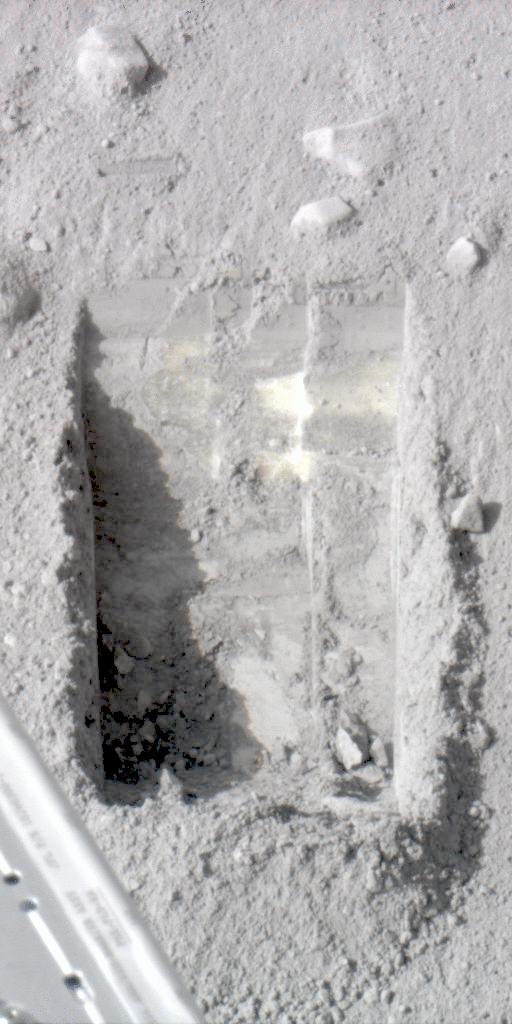

Phoenix scientists have been keeping an eye on the white material uncovered in a trench dug by the lander’s scoop. Dice-size nuggets of the bright material have vanished, convincing scientists the material was frozen water that vaporized after digging exposed it. The image here is a “movie” showing the material disappearing after four days. “It must be ice,” said Phoenix Principal Investigator Peter Smith. “These little clumps completely disappearing over the course of a few days, that is perfect evidence that it’s ice. There had been some question whether the bright material was salt. Salt can’t do that.”
The chunks were found at the bottom of a trench informally called “Dodo-Goldilocks” when Phoenix’s Robotic Arm enlarged that trench on June 15, during the 20th Martian day, or sol, since landing. Several were gone when Phoenix looked at the trench early today, on Sol 24.
“We know the ice is H2O but that doesn’t tell us much,” Smith said. “It is the impurities in the ice and the soil above the ice that tell us the history and if it is a habitable environment. We’ll now proceed to get the secrets out of the ice and use our instruments.”
Also on Thursday engineers said while digging in a different trench, the Robotic Arm connected with a hard surface that has scientists excited about the prospect of next uncovering an icy layer. Ray Arvidson, co-investigator for the robotic arm, said the hard layer was at the same depth as the ice layer in our the Dodo-Goldilocks trench.
The new trench, called “Snow White 2” trench, is in the middle of a polygon at the “Wonderland” site. While digging, the Robotic Arm came upon a firm layer, and after three attempts to dig further, the arm went into a holding position. Such an action is expected when the Robotic Arm comes upon a hard surface.
The Phoenix science team spent also Thursday analyzing new images and data successfully returned from the lander earlier in the day.
Meanwhile, Phoenix apparently suffered a problem with its flash memory on Tuesday, similar to, but not as serious as the problem that the Spirit Mars Exploration Rover encountered about 20 days after it landed on Mars back in 2004. The spacecraft team at Lockheed Martin Space Systems in Denver is preparing a software patch to send to Phoenix so scientific data can again be saved onboard overnight when needed. Because of a large amount a duplicative file-maintenance data generated by the spacecraft Tuesday, the team is taking the precaution of not storing science data in Phoenix’s flash memory, and instead downlinking it at the end of every day, until the conditions that produced those duplicative data files are corrected.
“We now understand what happened, and we can fix it with a software patch,” said Phoenix Project Manager Barry Goldstein of NASA’s Jet Propulsion Laboratory, Pasadena. “Our three-month schedule has 30 days of margin for contingencies like this, and we have used only one contingency day out of 24 sols. The mission is well ahead of schedule. We are making excellent progress toward full mission success.”
The Phoenix team will hold a press conference today (Friday) at 1:00 pm EST to discuss the latest findings.
Sources: Phoenix News
The Tucson Citizen
Wood has been a mainstay of human machines and construction for millennia. Its physical properties…
It’s easy to forget that, despite life having existed on Earth for billions of years…
It’s turns out that you don’t need a high-powered quantum experiment to observe Heisenberg’s uncertainty…
It’s not unusual for space probes to complete gravitational flyby manoeuvres en route to their…
According to the most widely held astronomical model (the Nebular Hypothesis), new stars are born…
The hunt for aliens goes hand in hand with the hunt for habitable planets. Astronomers…